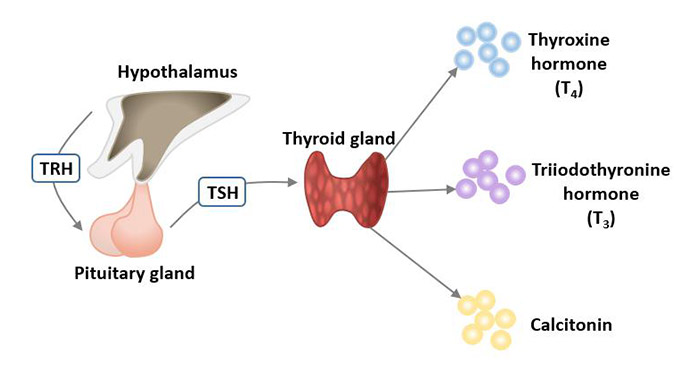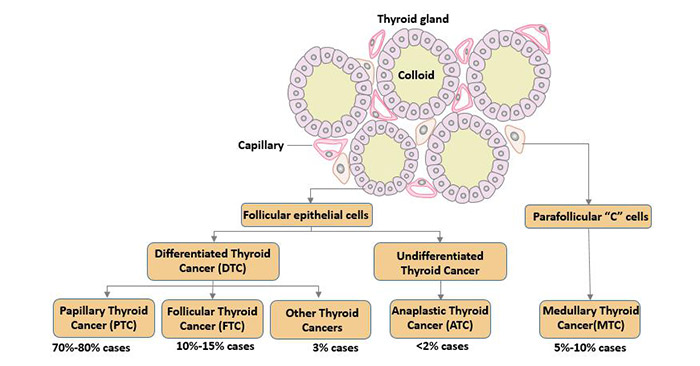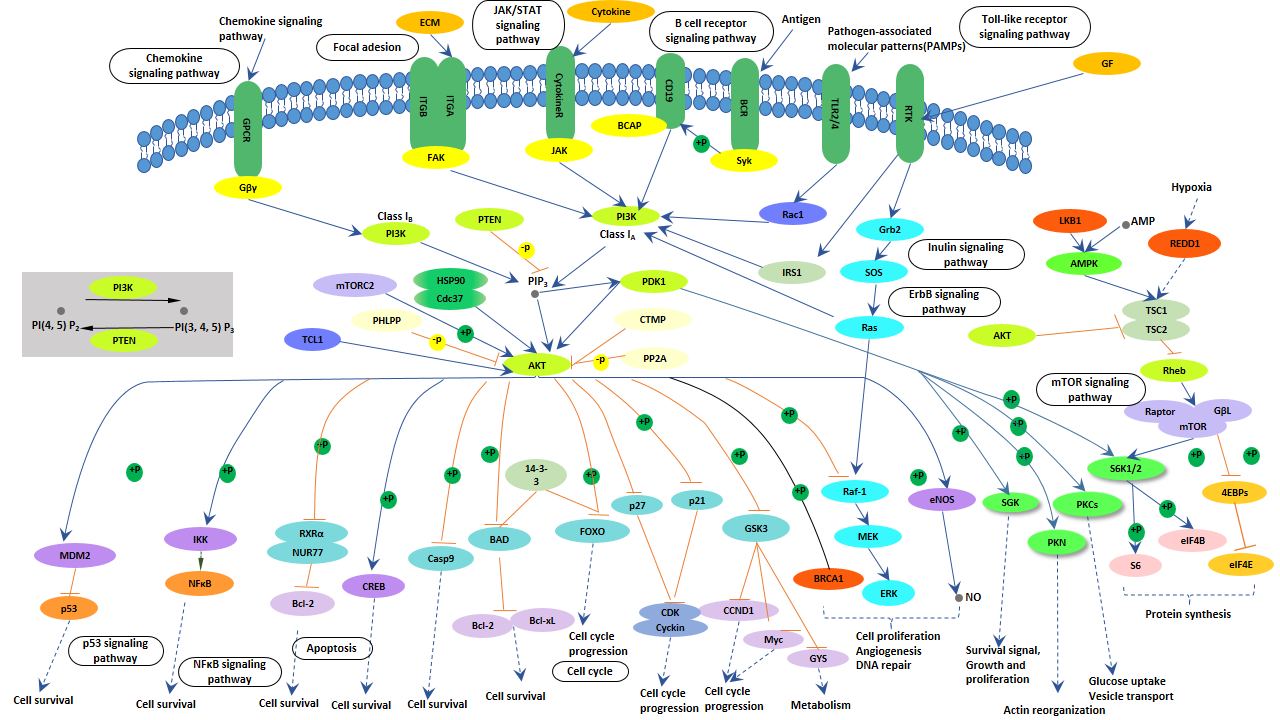[1] Kilfoy B, Zheng T, Holford T, et al. International patterns and trends in thyroid cancer incidence, 1973-2002 [J]. CANCER CAUSES & CONTROL, 2009, 20(5): 525-531.
[2] Arribas J, Castellvi J, Marcos R, et al. Expression of YY1 in Differentiated Thyroid Cancer [J]. Endocrine Pathology, 2015, 26(2): 111-118.
[3] Nagy R, Ringel M D. Genetic Predisposition for Nonmedullary Thyroid Cancer [J]. Hormones and Cancer, 2015, 6(1): 13-20.
[4] Nikiforov Y E, Nikiforova M N. Molecular genetics and diagnosis of thyroid cancer [J]. NATURE REVIEWS ENDOCRINOLOGY, 2011, 7(10): 569-580.
[5] Carneiro R M, Carneiro B A, Agulnik M, et al. Targeted therapies in advanced differentiated thyroid cancer [J]. Cancer Treatment Reviews, 2015, 41(8): S0305737215001243.
[6] Chiacchio S, Lorenzoni A, Boni G, et al. Anaplastic thyroid cancer: Prevalence, diagnosis and treatment [J]. Minerva endocrinologica, 2009, 33(4): 341-357.
[7] Xu B, Ghossein R. Genomic Landscape of poorly Differentiated and Anaplastic Thyroid Carcinoma [J]. Endocrine Pathology, 2016, 27(3): 205-212.
[8] Chiappetta G, Valentino T, Vitiello M, et al. PATZ1 acts as a tumor suppressor in thyroid cancer via targeting p53-dependent genes involved in EMT and cell migration [J]. Oncotarget, 2014, 6(7): 5310-23.
[9] Hoang J K, Nguyen X V, Davies L. Overdiagnosis of Thyroid Cancer: Answers to Five Key Questions [J]. Academic Radiology, 2015, 22(8): 1024-1029.
[10] Nikiforov, Y. E., & Nikiforova, M. N. Molecular genetics and diagnosis of thyroid cancer. Nature Reviews Endocrinology,2011. 7(10), 569–580.
[11] Xing, M. BRAF mutation in papillary thyroid cancer: Pathogenic role, molecular bases, and clinical implications. Endocrine Reviews, 2007. 28(7), 742–762.
[12] Ron, E., & Schneider, A. B. Thyroid cancer. In Schottenfeld, D., Fraumeni, J. F., & Fraumeni Jr, J. F. (Eds.), Cancer epidemiology and prevention (3rd ed.). Oxford: Oxford University Press.2006.
[13] Fagin, J. A., & Wells Jr, S. A.Biologic and Clinical Perspectives on Thyroid Cancer. New England Journal of Medicine, 2016. 375(23), 2307–2320.
[14] Xing, M. BRAF mutation in papillary thyroid cancer: Pathogenic role, molecular bases, and clinical implications. Endocrine Reviews,2007. 28(7), 742–762.
[15] Xing, M. Molecular pathogenesis and mechanisms of thyroid cancer. Nature Reviews Cancer, 2013. 13(3), 184–199.
[16] Subbiah, V., Kreitman, R. J., Wainberg, Z. A., et al. Dabrafenib and trametinib treatment in patients with locally advanced or metastatic BRAF V600–mutant anaplastic thyroid cancer. JCO Precision Oncology, 2019. 3, 1–10.
[17] Liu, Z., Hou, P., Ji, M., Guan, H., et al. Highly prevalent genetic alterations in receptor tyrosine kinases and phosphatidylinositol 3-kinase/akt and mitogen-activated protein kinase pathways in anaplastic and follicular thyroid cancers. Journal of Clinical Endocrinology & Metabolism, 2018. 93(8), 3106–3116.
[18] Wells Jr, S. A., Santoro, M., & Matrone, A. RET codon 634 mutations in multiple endocrine neoplasia type 2: Genotype-phenotype correlations and implications in clinical management. The Journal of Clinical Endocrinology & Metabolism, 1994. 78(3), 767–771.
[19] Pelicano, H., Martin, D. S., Xu, R. H., & Huang, P. Glycolysis inhibition for anticancer treatment. Oncogene, 2006. 25(34), 4633–4646.
[20] Porstmann, T., Griffiths, B., Chung, Y. L. et al. PKB/Akt induces transcription of enzymes involved in cholesterol and fatty acid biosynthesis via activation of SREBP. Oncogene, 2005. 24(43), 6465–6481. ↩
[21] Suhane, S., Ramanujan, V. K., & Thyagarajan, K. Targeting lipid metabolism synergizes with GSK-3 inhibition and induces apoptosis in liposarcoma. PloS One, 2011. 6(9), e24563.
[22]Lori J Wirth; Eric Sherman; Bruce Robinson, et al. "Efficacy of Selpercatinib in RET-Altered Thyroid Cancers", THE NEW ENGLAND JOURNAL OF MEDICINE, 2020.
[23]Vivek Subbiah; Mimi I Hu; Lori J Wirth; Martin Schuler, et al. "Pralsetinib for Patients with Advanced or Metastatic RET-altered Thyroid Cancer (ARROW): A Multi-cohort, Open-label, Registrational, Phase 1/2 Study", THE LANCET. DIABETES & ENDOCRINOLOGY, 2021.
[24] Jeesu Kim; Byullee Park; Jeonghoon Ha, et al."Multiparametric Photoacoustic Analysis of Human Thyroid Cancers In Vivo", CANCER RESEARCH, 2021.







Comments
Leave a Comment